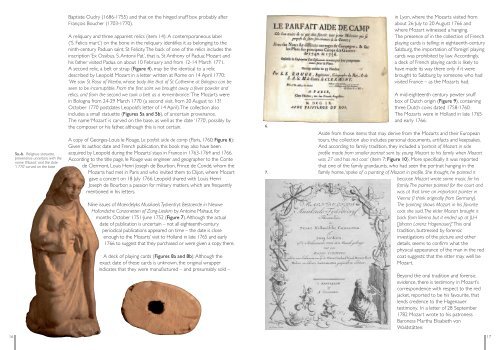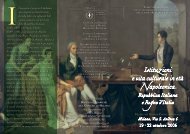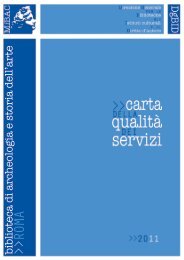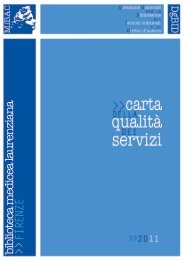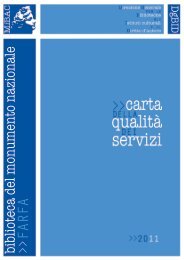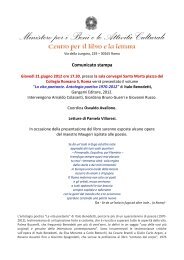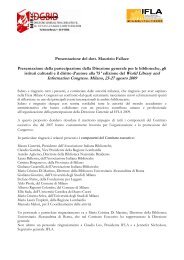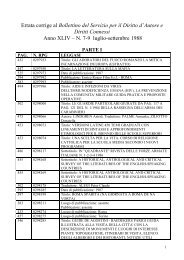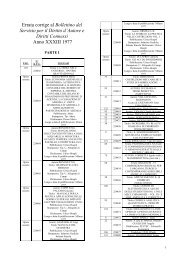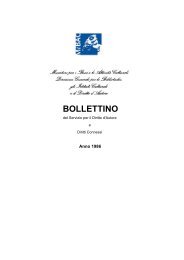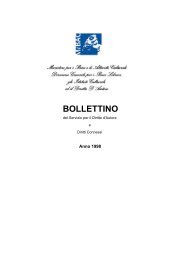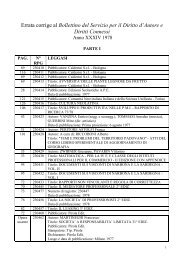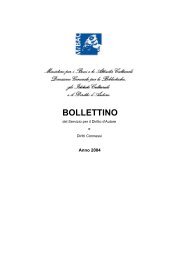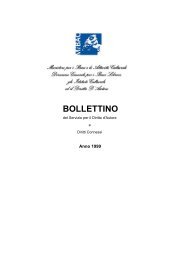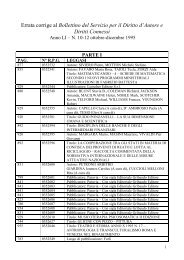Opuscolo (Pdf) - Direzione Generale per i Beni Librari e gli Istituti ...
Opuscolo (Pdf) - Direzione Generale per i Beni Librari e gli Istituti ...
Opuscolo (Pdf) - Direzione Generale per i Beni Librari e gli Istituti ...
You also want an ePaper? Increase the reach of your titles
YUMPU automatically turns print PDFs into web optimized ePapers that Google loves.
5a.-b. Religious statuette,<br />
provenance uncertain, with the<br />
name ‘Mozart’ and the date<br />
‘1770’ carved on the base<br />
Baptiste Oudry (1686-1755) and that on the hinged snuff box probably after<br />
François Boucher (1703-1770).<br />
A reliquary and three apparent relics (item 14): A contemporaneous label<br />
(‘S. Felicis mart.’) on the bone in the reliquary identifies it as belonging to the<br />
ninth-century Paduan saint, St Felicity.The back of one of the relics includes the<br />
inscription ‘Ex Ossibus. S. Antonii Pat.’, that is, St Anthony of Padua; Mozart and<br />
his father visited Padua on about 10 February and from 12-14 March 1771.<br />
A second relic, a belt or strap (Figure 4), may be the identical to a relic<br />
described by Leopold Mozart in a letter written at Rome on 14 April 1770:<br />
‘We saw St Rosa of Viterbo, whose body like that of St Catherine at Bologna can be<br />
seen to be incorruptible. From the first saint we brought away a fever powder and<br />
relics, and from the second we took a belt as a remembrance.’ The Mozarts were<br />
in Bologna from 24-29 March 1770 (a second visit, from 20 August to 13?<br />
October 1770 postdates Leopold’s letter of 14 April).The collection also<br />
includes a small statuette (Figures 5a and 5b), of uncertain provenance.<br />
The name ‘Mozart’ is carved on the base, as well as the date ‘1770’, possibly by<br />
the composer or his father, although this is not certain.<br />
A copy of Georges-Louis le Rouge, Le parfait aide de camp (Paris, 1760; Figure 6):<br />
Given its author, date and French publication, this book may also have been<br />
acquired by Leopold during the Mozarts’ stays in France in 1763-1764 and 1766.<br />
According to the title page, le Rouge was engineer and geographer to the Conte<br />
de Clermont, Louis Henri Joseph de Bourbon, Prince de Condé, whom the<br />
Mozarts had met in Paris and who invited them to Dijon, where Mozart<br />
gave a concert on 18 July 1766. Leopold shared with Louis Henri<br />
Joseph de Bourbon a passion for military matters, which are frequently<br />
mentioned in his letters.<br />
Nine issues of Maendelyks Musikaels Tydverdryt: Bestaende in Nieuwe<br />
Hollandsche Canzonetten of Zang-Liedern by Antoine Mahaut, for<br />
months October 1751-June 1752 (Figure 7).Although the actual<br />
date of publication is uncertain – not all eighteenth-century<br />
<strong>per</strong>iodical publications appeared on time – the date is close<br />
enough to the Mozarts’ visit to Holland in late 1765 and early<br />
1766 to suggest that they purchased or were given a copy there.<br />
A deck of playing cards (Figures 8a and 8b): Although the<br />
exact date of these cards is unknown, the original wrap<strong>per</strong><br />
indicates that they were manufactured – and presumably sold –<br />
in Lyon, where the Mozarts visited from<br />
about 26 July to 20 August 1766 and<br />
where Mozart witnessed a hanging.<br />
The presence of in the collection of French<br />
playing cards is telling: in eighteenth-century<br />
Salzburg, the importation of ‘foreign’ playing<br />
cards was prohibited by law. Accordingly,<br />
a deck of French playing cards is likely to<br />
have made its way there only if it were<br />
brought to Salzburg by someone who had<br />
visited France – as the Mozarts had.<br />
A mid-eighteenth century pewter snuff<br />
box of Dutch origin (Figure 9), containing<br />
three Dutch coins dated 1758-1760.<br />
The Mozarts were in Holland in late 1765<br />
and early 1766.<br />
Aside from those items that may derive from the Mozarts and their European<br />
tours, the collection also includes <strong>per</strong>sonal documents, artifacts and keepsakes.<br />
And according to family tradition, they included a ‘portrait of Mozart in side<br />
profile made from smaller portrait sent by young Mozart to his family when Mozart<br />
was 27 and has red coat’ (item 7; Figure 10). More specifically it was reported<br />
that one of the family grandaunts, who had seen the portrait hanging in the<br />
family home,‘spoke of a painting of Mozart in profile. She thought, he painted it<br />
because Mozart wrote some music for his<br />
family.The painter painted for the court and<br />
was at that time an important painter in<br />
Vienna (I think originally from Germany).<br />
The painting shows Mozart in his favorite<br />
coat she said.The elder Mozart brought it<br />
back from Vienna but it ended up at JLH<br />
[Johann Lorenz Hagenauer].’This oral<br />
tradition, buttressed by forensic<br />
investigations of the picture and other<br />
details, seems to confirm what the<br />
physical appearance of the man in the red<br />
coat suggests: that the sitter may well be<br />
Mozart.<br />
Beyond the oral tradition and forensic<br />
evidence, there is testimony in Mozart’s<br />
correspondence with respect to the red<br />
jacket, reported to be his favourite, that<br />
lends credence to the Hagenauer<br />
testimony. In a letter of 28 September<br />
1782 Mozart wrote to his patroness<br />
Baroness Martha Elisabeth von<br />
Waldstätten:<br />
16 17<br />
6.<br />
7.


